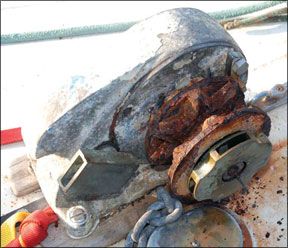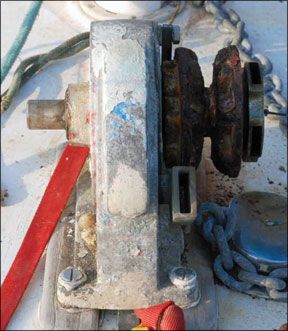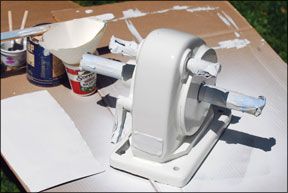I’ve got an old manual anchor windlass with a badly corroded gypsy that needs to be replaced. There is a 1:1 bronze “cross” on the outside of the gypsy—where the lever fits to turn it when not using the geared mechanism. Unfortunately, I can’t

Photos courtesy of Gary Aitkin and by Ralph Naranjo
288
figure out how to get the bronze cross off, which needs to happen in order to replace the gypsy. There’s a grease zirk/fender washer on the outside of the cross, but unscrewing it still doesn’t get the cross off.
The drum on the port side came off relatively easily after removing a bolt and fender washer, using a wheel puller. The drum was prevented from slipping on the shaft by a piece of wood in a quarter-inch slot where originally I presume there was a steel key.
Also, I can’t find any manufacturer’s information anywhere on it. I’ve attached a couple of photos. Do you know who the maker is?
Gary Aitken
Malakii, Morgan 302
Bahia de Buena Vista, Guatemala
The windlass in the pictures you sent is an old Simpson Lawrence, a British-engineered oddity that many owners

288
cursed. They used a chain rather than a gear drive, and this led to problems. The cast-steel chain gypsy, aluminum case, and the chain issue make your windlass a less than prime candidate for rebuilding. We would recommend instead looking for a used manual Nilsson windlass. While Nilsson has been out of business in the U.S. for a while, the company’s used windlasses are a good find. Check out secondhand chandleries, nautical flea markets, and eBay. A little TLC and a good check of the windlass’ bearings, gears, seals, and housing can turn a derelict piece of hardware into a “like new” foredeck appendage.
We featured the rebuild of an old, reliable hand-crank Nilsson in the October 2009 issue. It was in the final stages of a refit and was awaiting a new paint job. When painting cast-aluminum housings like the Nilsson’s, prep is especially important because they love to oxidize, particularly under a glossy finish coat.
The key to success lies in the abrasive removal of all old paint,

288
primer, and oxidation. Next comes a solvent wipe down, followed up with a single, very thin coat of etching primer, such as Interlux’s acid etch primer 353/354. As soon as the surface dries, overcoat with 404/414 barrier coat, scuff sand, and apply two or more coats of a one- or two-part urethane topcoat such as Toplac or Perfection. Spray application offers the best results, but carefully follow all safety precautions.
Insulating the bolt holes and windlass body from the stainless-steel mounting bolts will prevent galvanic corrosion that can harm the finish.







































